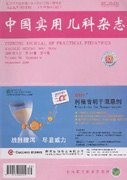|
Clinical study of dynamic changes of T lymphocyte level in children with protracted bacterial bronchitis
JIA Chun-mei,JIANG Cai-rong,NING Li-hua,et al
2019, 34(11):
931-935.
DOI: 10.19538/j.ek2019110613
Objective To investigate the relationship between pathogenesis of PBB and the T cell subsets disorders and to evaluate the clinical significance of immunomodulatory therapy to the prognosis of PBB and the prevention of recurrent PBB. Methods A total of 127 cases of PBB children treated in the Fourth Hospital of Baotou City from May 2015 to May 2018 were selected. Blood samples were collected before treatment,and the levels of CD4,CD8 cells and CD4/CD8 in peripheral blood T cell subsets were detected by flow cytometry. All children with PBB(PBB group) were given oral amoxicillin and clavulanate potassium for 2 to 4 weeks. The subjects were divided into Huaiqihuang group(n=66) and non-Huaiqihuang group(n=66). The Huaiqihuang group was given Huaiqihuang granules based on the anti-infective treatment. In addition,healthy children were enrolled as control group(n=39). T cell subsets of the two groups were reexamined 3 months after treatment. By analyzing the cough symptom scores of all children after 2 weeks, 4 weeks and 12 weeks of treatment,the rate of cure and improvement and the recurrence rate after 1 year were evaluated. SPSS16.0 software was used for data processing, and the difference was significant if P<0.05. Results Before treatment,there were 48 cases(37.80%) of CD4/CD8 abnormalities in the PBB group and 4 cases(10.26%) in the control group. The difference between the two groups was statistically significant(P<0.01). After treatment, the number of abnormal CD4/CD8 cases in the PBB group was reduced to 18 cases(14.17%), and the difference was statistically significant compared with that before treatment(P<0.01). Prior to treatment, there were 33 cases(50.00%) of abnormal CD4/CD8 in Huaiqihuang group, and the number decreased to 8 cases(12.12%) after 12 weeks of treatment, showing statistically significant differences(P<0.01). However, in the non-Huaiqihuang group, there were 15 cases(24.59%) of CD4/CD8 abnormality before treatment, and 10 cases(16.39%) of CD4/CD8 abnormality after treatment, showing no statistically significant difference(P>0.05). In 2 weeks after treatment, the cough symptom scores of the PBB group began to decrease, and the non-Huaiqihuang group decreased more significantly, with statistically significant difference(P<0.05). After 4 weeks and 12 weeks of continuous treatment, although the cough symptom scores of the PBB group continued to decrease, the difference between the two groups was not statistically significant(P>0.05). Follow-up showed that the recurrence rate of Huaiqihuang group was lower than that of non-Huaiqihuang group in 1 year after the end of treatment, and the difference between the two groups was statistically significant(P<0.01). Conclusion Children with PBB have T cell subsets disorder, and the treatment of anti-infection combined with Huaiqihuang granules for at least 4 weeks has a positive effect on PBB prognosis and recurrence prevention.
|

